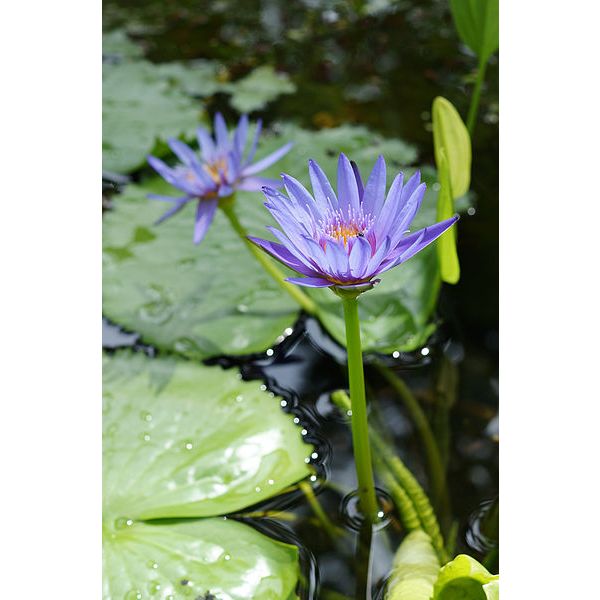Nymphaea Capensis Purple Seeds (Cape Blue Water Lily Seeds)
Nymphaea Capensis Purple Seeds (Cape Blue Water Lily Seeds)
The Capensis large, elegant blue flowers are held well above the water at the tip of a sturdy green stalk. This plant blooms repeatedly from mid-spring to early fall.

Delivery
All orders shipped with UPS Express.
Always free shipping for orders over US $250.
All orders are shipped with a UPS tracking number.
Returns
Items returned within 14 days of their original shipment date in same as new condition will be eligible for a full refund or store credit.
Refunds will be charged back to the original form of payment used for purchase.
Customer is responsible for shipping charges when making returns and shipping/handling fees of original purchase is non-refundable.
All sale items are final purchases.
Help
Give us a shout if you have any other questions and/or concerns.
Email: contact@domain.com
Phone: +1 (23) 456 789
Availability: Out of stock
SKU
Graines Nymphaea Capensis Mauve (Graines Lotier d'Egypte)
Nymphaea Capensis is native to South Africa Madagascar and is also known as Nymphaea Nouchali var.Caerulea, N.Calliantha, N.Mildbraedii, N.Spectabilis, and Cape Blue Water-Lily. It is found growing abundantly in freshwater habitats in South Africa and neighboring countries. This plant's bulb can survive relatively long periods of time without rainfall in a dry river bed. During the rain season, as the riverbed or bog fills up, the bulb will sprout leaves and flowers. The blue lotus, Nymphaea Caerulea, the Cape blue water lily, and Nymphaea Capensis are no longer regarded as distinct species and have been sunk into this genus.
Water lilies are without doubt the most beautiful aquatic plants and are a must for every sunny water garden. But they need not only be used in ponds. Innovative gardeners with small gardens and sunny courtyards can enjoy them too, as they can be successfully grown in a variety of water-filled pottery containers, wooden barrels, old kitchen sinks and water features.
N. Capensis is a clump forming perennial with shiny, glossy leaf-blades that are up to 40 cm in diameter, green, minutely pimpled on both sides with prominent veins below, wavy margin, bluntly toothed and cleft almost to the centre where the petiole is attached. Nymphaea Capensis mature leaves are lightly blotched with wavy margins and slightly blunt-toothed. The water lily does not have true stems; the leaves are on long petioles (leaf stalks) that arise directly from the rhizome.
The Capensis large, elegant blue flowers are held well above the water at the tip of a sturdy green stalk. This plant blooms repeatedly from mid-spring to early fall. The flowers are bisexual, star-like and regular, with 4 sepals, green on the outside and white to blue on the inside, with up to 30 petals, about 5 cm long and 1.5 cm wide. In the centre of the flower are numerous blue-tipped bright golden yellow stamens and green sepals. The innermost petals show a transition to the stamens, which are up to 4 cm long. They are sweet-scented and strongly pervasive. Cut blooms last well in a bright room.
The flowers open in early to mid-morning and close completely in late afternoon and stay closed all night. The opening and closing mechanism of the flowers is controlled by the sepals. If they are removed, the flower loses the ability to close. A fully open flower measures 15-20 cm across and each flower lasts for about four days. The flowers are visited constantly by bees who are the most likely pollinator. Nymphaea Capensis does not have a creeping rootstock; the root is large and bulbous and will not reproduce as do other species from eyes or adventitious buds.
Hardiness:
10-11 (1c/35f, 4c/40f) Nymphaea Capensis is a wild water lily easily grown except where limestone is present. It is hardy in the north down to about 1c but it is doubtful that it will survive in colder regions. Nymphaea Capensis requires a composted rich topsoil mix which is slightly acid. Although the blue water lily does go dormant during the winter, it should be left in the water throughout its dormancy. At the coast they keep their leaves during winter. The planting container should be larger than normal and topped with gravel. Often the bulb has to be tied down before the plant starts to grow to prevent it floating out loose The Cape blue water lily grows best in full sun to semi-sun and in relatively shallow water, and they also prefer still water and don?t like the wind.
| Common name | Cape Blue Water Lily |
|---|---|
| Species | Nymphaea capensis |
| Cultivar | Purple |
| Germination | Sow indoors before last frost or direct sow after last frost. Seed propagation is easy and usually successful. Finely sieved clean loam soil without any organic matter or fertilizer is best. Seed should be sown thinly, covered lightly with soil and then plunged into shallow water, no deeper than 2.5 cm, and placed in a sunny position. Germination should take 3-4 weeks. The seedlings will look like fine grass at first, developing true leaves later. When the first two or three floating leaves appear, the seedling should be pricked out and planted into individual containers and immersed back in the water. They may be submerged into deeper water and larger containers as they grow and lengthen. Germination can take longer. Be patient! |
| Price View | Price Range |

